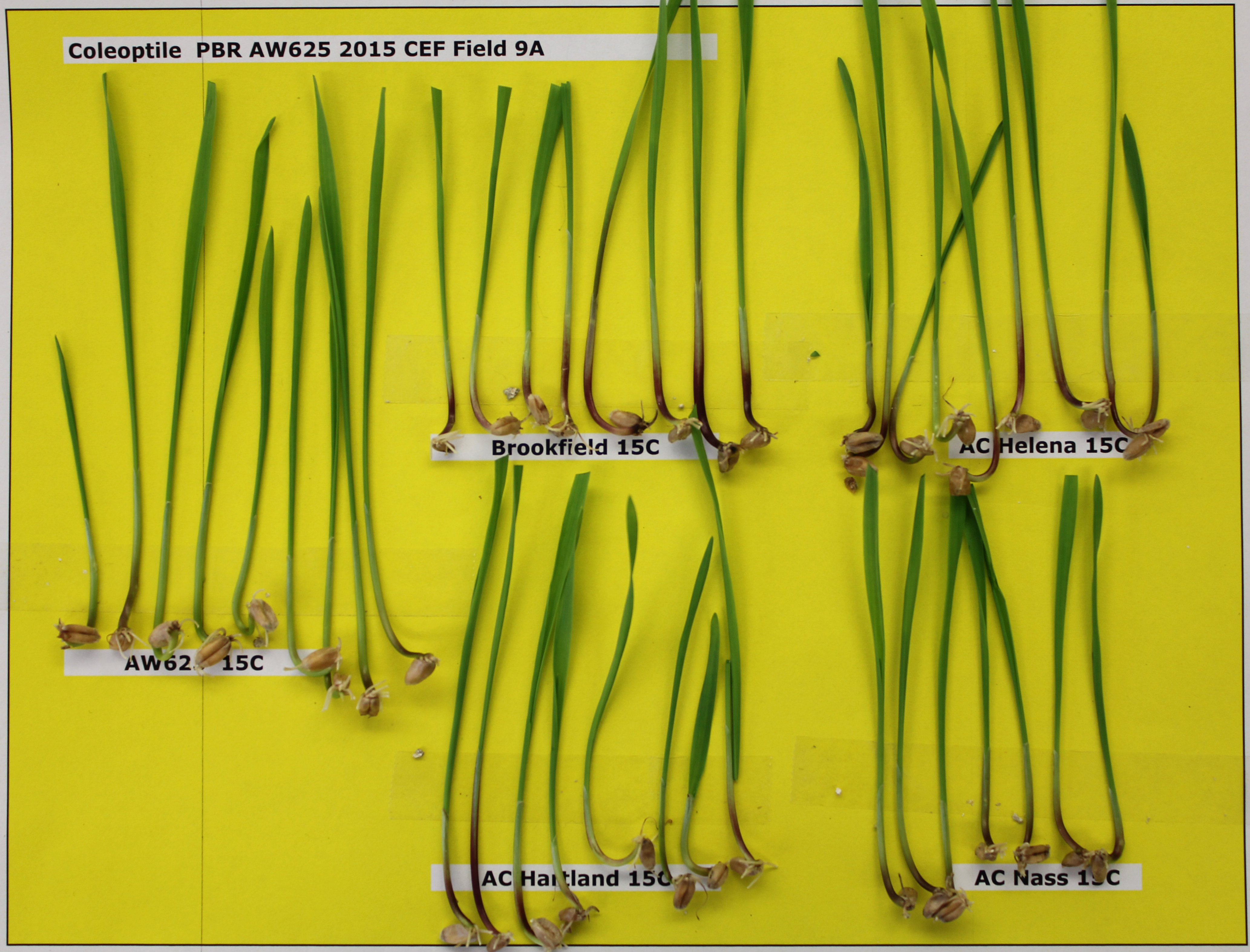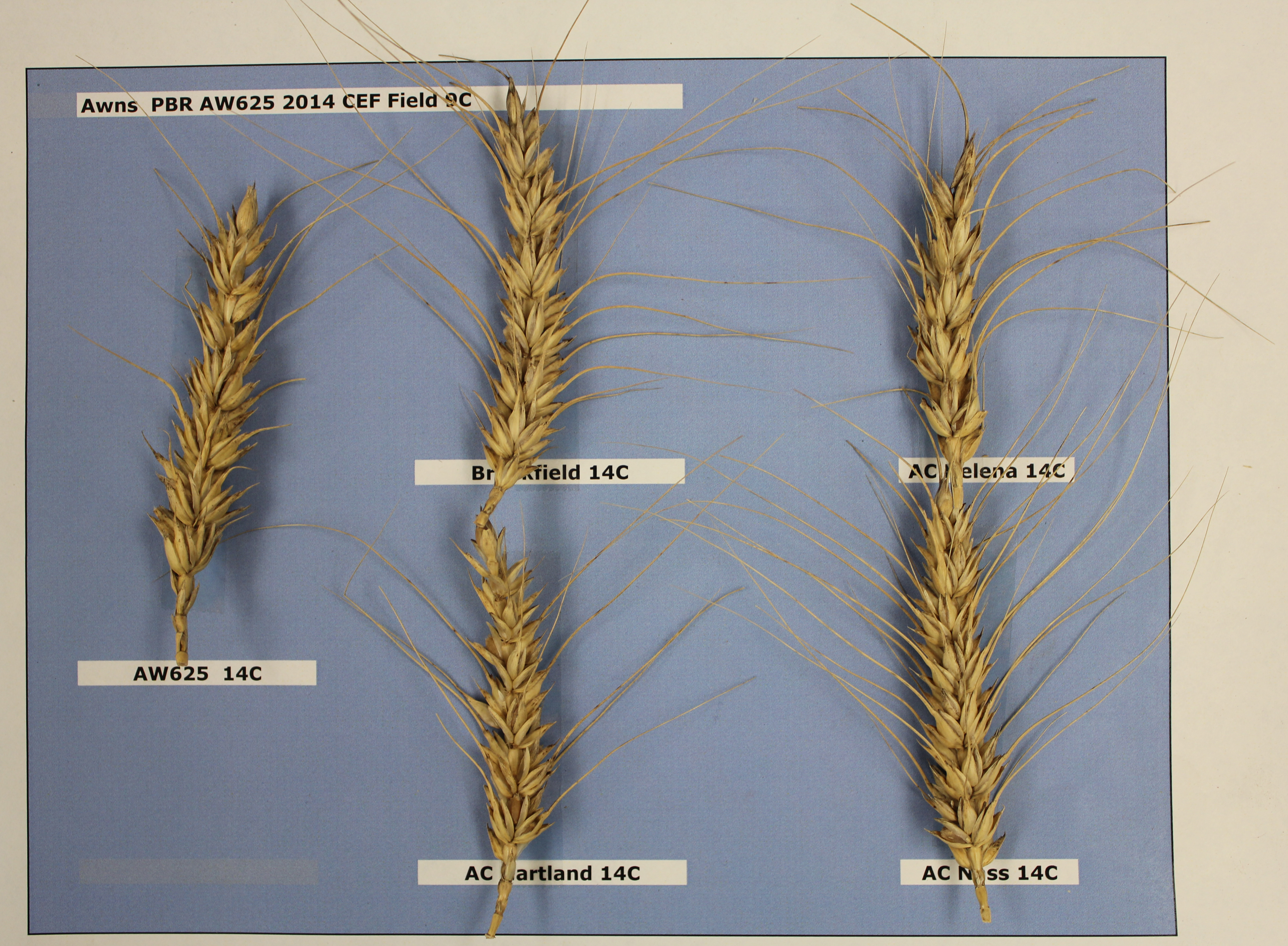AAC Scotia
| Denomination: | 'AAC Scotia' |
|---|---|
| Previously Proposed Denomination: | 'Scotia' |
| Botanical Name: | Triticum aestivum |
| Applicant/Holder: |
Agriculture & Agri-Food Canada, Ottawa Ottawa Research and Development Centre Room 1093A - 960 Carling Avenue Ottawa, Ontario K1A 0C6 Canada |
| Breeder: |
Harvey Voldeng, Agriculture & Agri-Food Canada, Ottawa, Ontario |
| Agent in Canada: |
Agriculture & Agri-Food Canada Office of Intellectual Property and Commercialization c/o Shannon Whyte 107 Science Place Saskatoon, Saskatchewan S7N 0X2 Canada Tel: (204) 999-9887 |
| Application Date: | 2011-05-04 |
| Application Number: | 11-7284 |
| Grant of Rights Date: | 2018-02-14 |
| Certificate Number: | 5653 |
| Grant of Rights Termination Date: | 2038-02-14 |
Variety Description
Varieties used for comparison: 'Brookfield', 'AC Helena', 'AC Hartland' and 'Nass'
Summary: The intensity of the anthocyanin colouration of the coleoptile of 'AAC Scotia' is absent to weak whereas it is of medium intensity for 'Brookfield' and 'AC Helena'. 'AAC Scotia' is later heading than 'AC Helena'. The glaucosity of the spike of 'AAC Scotia' is medium to strong whereas it is weak to medium for 'AC Hartland'. At the tip of the spike, the awns are shorter than the spike length for 'ACC Scotia' whereas they are equal for the reference varieties. 'AAC Scotia' has an angular kernel cheek shape whereas it is rounded for 'Brookfield'. The phenol colouration of the kernel of 'AAC Scotia' is medium to very dark whereas it is light for 'Nass'.
Description:
PLANT: hard red common spring type, semi-erect growth habit at 5 to 9 tiller stage, high to very high frequency of plants with recurved flag leaves, matures late
SEEDLING (4-leaf stage): absent to weak intensity of anthocyanin colouration of coleoptile, glabrous sheath and blade of lower leaves
FLAG LEAF: absent or very weak intensity of anthocyanin colouration of auricles, medium glaucosity of sheath, glabrous blade and sheath
CULM: medium glaucosity, straight neck
STRAW (AT MATURITY): thin pith in cross-section, no anthocyanin colouration at maturity
SPIKE: medium to strong glaucosity at heading, parallel sided shape in profile, medium density, white at maturity, inclined attitude, sparse to medium pubescence of convex surface of apical rachis segment
AWNS: awnlets on lower half and awns on upper half of spike; awns at tip of spike are shorter than length of spike, white at maturity
LOWER GLUME SHOULDER: narrow, slightly sloping shape
LOWER GLUME: medium length, narrow to medium width, glabrous, sparse extent of internal hairs
LOWER GLUME BEAK: short, straight shape
LOWEST LEMMA: straight beak
KERNEL: medium red, small, short to medium length, narrow to medium width, elliptical shape, angular cheek, short to medium length of brush hairs, medium width and depth of crease, medium to very dark phenol colouration
GERM: medium to large, broad elliptical in shape
BREAD MAKING QUALITY: fair
DISEASE REACTION: resistant to moderately resistant to Leaf Rust (Puccinia triticina)
Origin & Breeding History: 'AAC Scotia' (experimental designations 'AW625' and '01-81-1') originated from the cross between 'Quantum' and 'AC Walton' made in the winter of 2001 at the Crops and Livestock Research Centre in Charlottetown, Prince Edward Island, Canada. Resulting F1 seeds were sown in the field in single rows in the summer of 2001 and selected rows harvested in bulk. In 2002, F2 seeds were sown as a population in the field and selected heads harvested. In 2003, the heads were grown in head rows and selected ones harvested in bulk. The line '01-81-1' was evaluated in a 2 replicate trial in Harrington, Prince Edward Island. In 2005, line '01-81-1' was advanced to the Preliminary Spring Wheat Trial at Harrington and Ottawa. Initial selection criteria included powdery mildew and Fusarium Head Blight resistance, resistance to lodging, and large and well filled heads. Row selection in the F3 was for the same traits plus awn length, plant height, spike colour and uniformity of plants within the row. Similar criteria were used in the preliminary yield trials plus grain yield, 1000-kernel weight and test weight. In 2006, '01-81-1' was designated as 'AW625' and entered into the Eastern Spring Wheat Screening Test at eight locations in Eastern Canada. In 2007 and 2008, 'AW625' was entered into the Maritime Spring Wheat Registration and Recommendation trials, the Quebec Spring Wheat Registration Trial and the Ontario Orthogonal Registration Trials. 'AAC Scotia' was also evaluated in Performance trials in 2009 and 2010. Selection criteria in multi-location yield trials in Eastern Canada were grain yield, wide area adaptation, uniformity, Fusarium Head Blight resistance, and grain and flour quality.
Tests & Trials: The comparative tests and trials for 'AAC Scotia' were conducted during the 2014 and 2015 growing seasons at the Agriculture and Agri-Food Canada Eastern Cereal Oilseed Research Centre on the Central Experimental Farm in Ottawa, Ontario, Canada. The trials were arranged in a Randomized Complete Block Design with 3 replicates in 2014 and 4 replicates in 2015. Each plot consisted of 6 rows spaced 20 centimetres apart and 4.2 metres long resulting in approximately 3000 plants per plot.
Comparison table for 'AAC Scotia' with reference varieties 'Brookfield', 'AC Helena', 'AC Hartland' and 'Nass'
Days to heading (from planting to 50% of heads fully emerged)
| 'AAC Scotia' | 'Brookfield' | 'AC Helena' | 'AC Hartland' | 'Nass' | |
|---|---|---|---|---|---|
| mean (2014) | 51 | 46 | 46 | 48 | 47 |
| mean (2015) | 56 | 56 | 53 | 56 | 56 |
Click on image for larger view

Wheat: 'AAC Scotia' (left) with reference varieties 'Brookfield' (top centre), 'AC Helena' (top right), 'AC Hartland' (bottom centre) and 'Nass' (bottom right)
Click on image for larger view

Wheat: 'AAC Scotia' (left) with reference varieties 'Brookfield' (top centre), 'AC Helena' (top right), 'AC Hartland' (bottom centre) and 'Nass' (bottom right)
- Date modified: